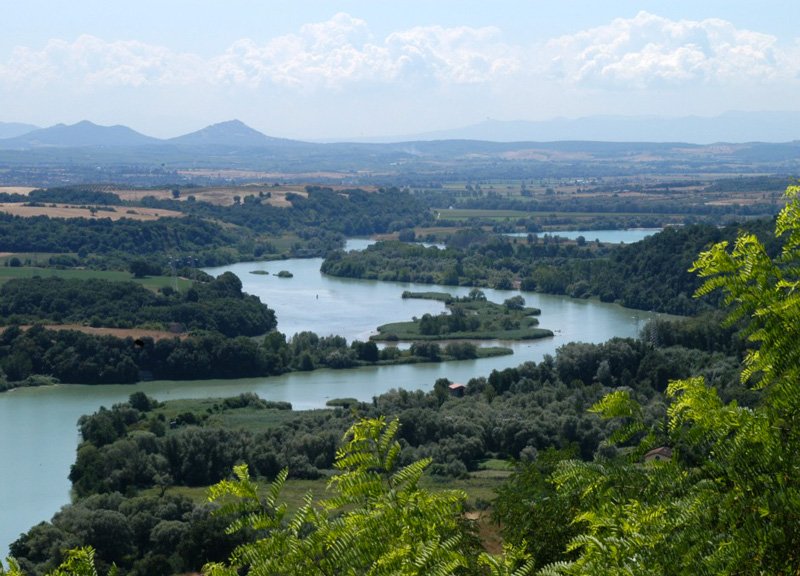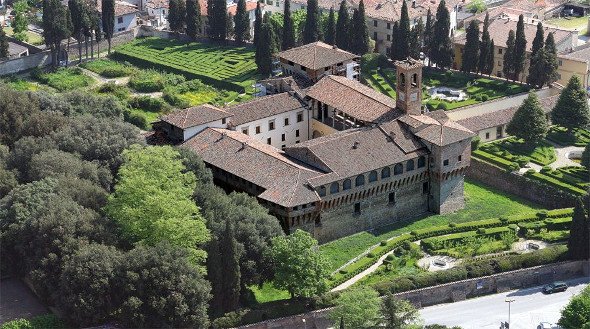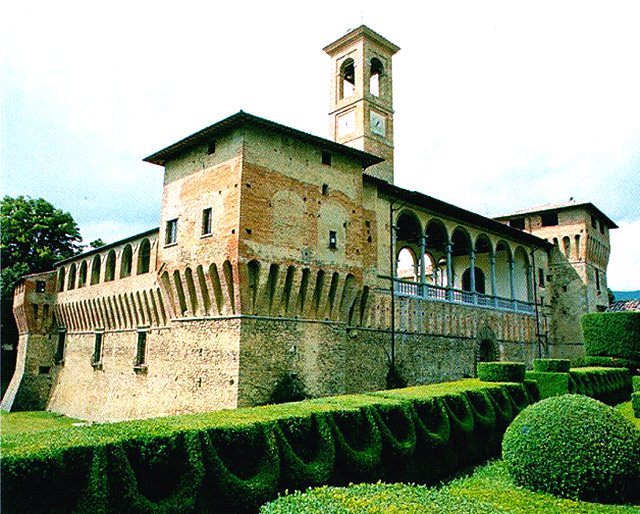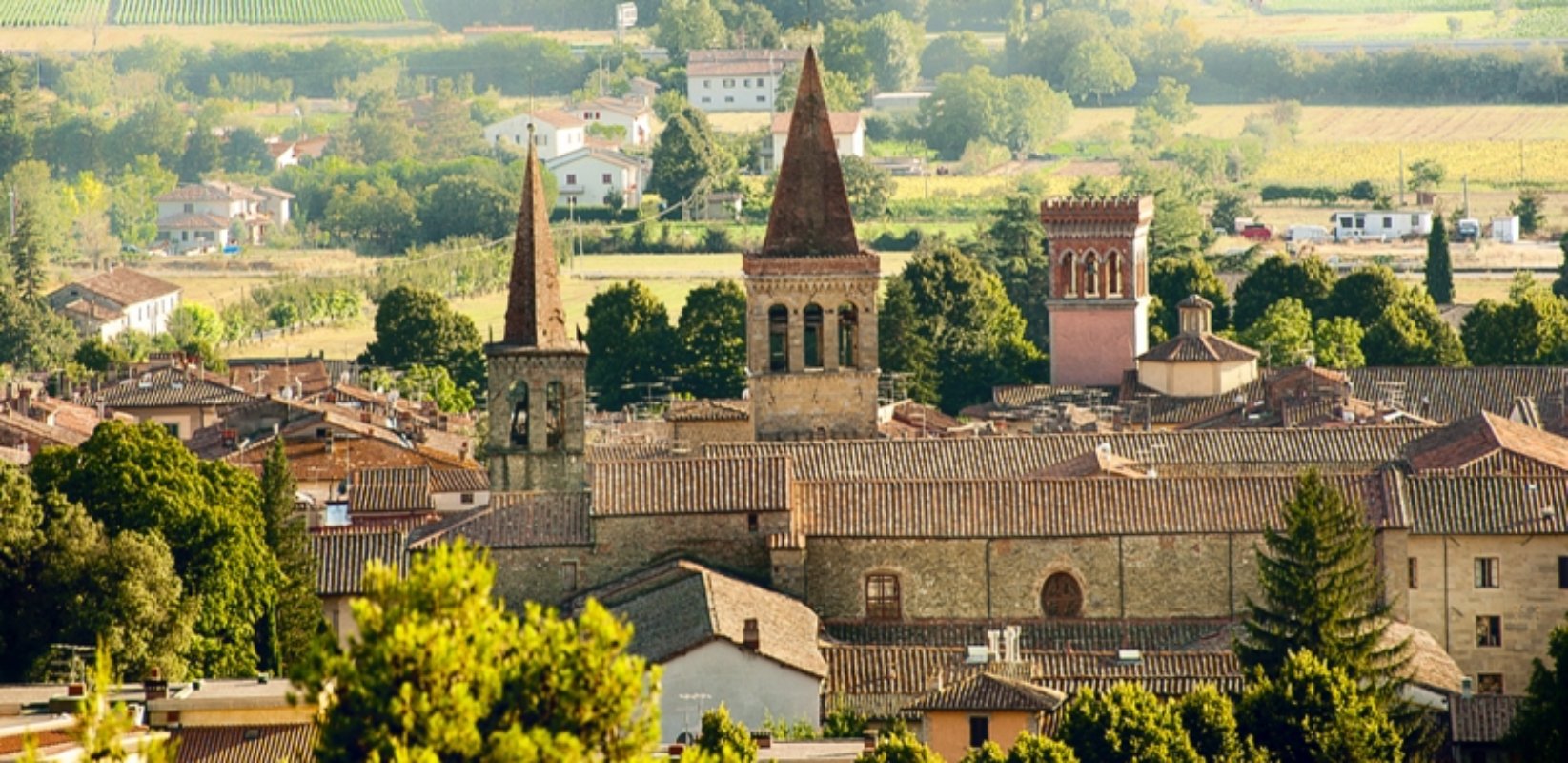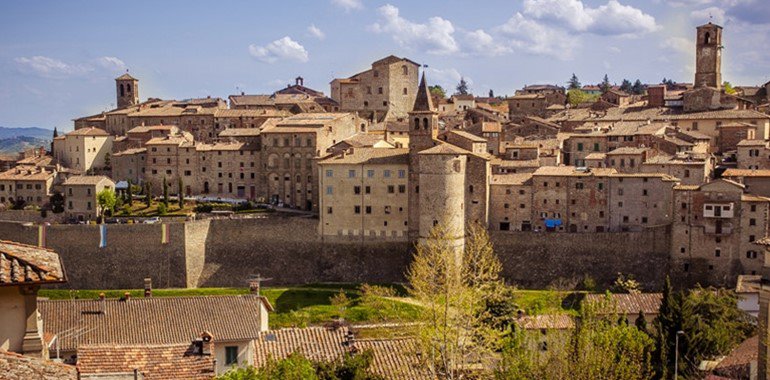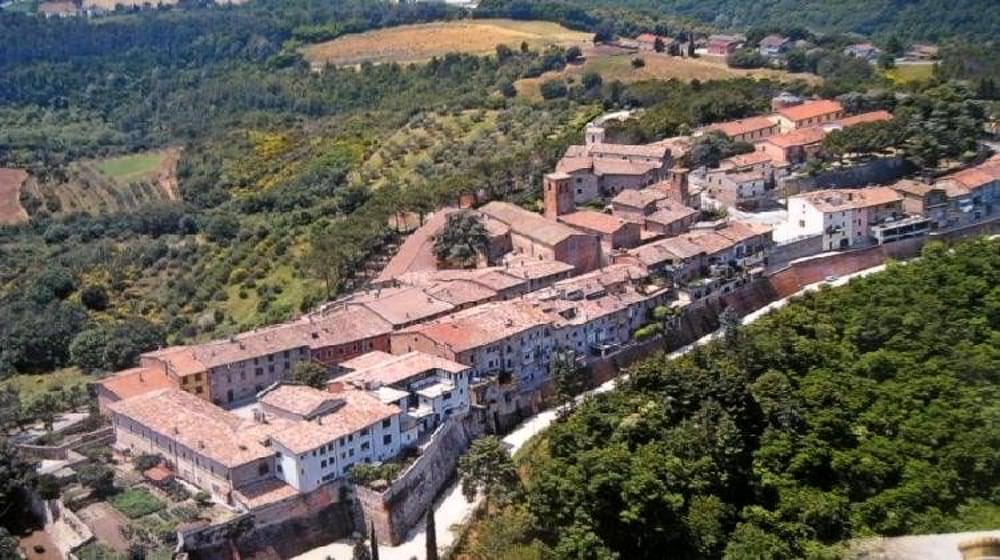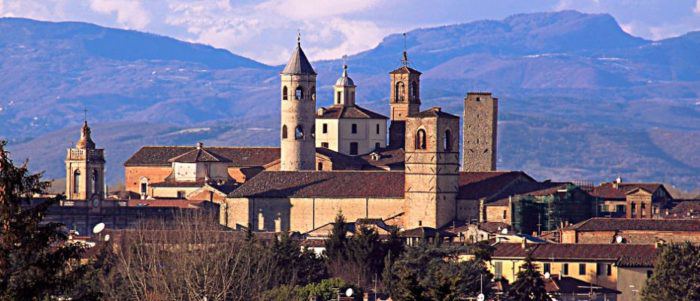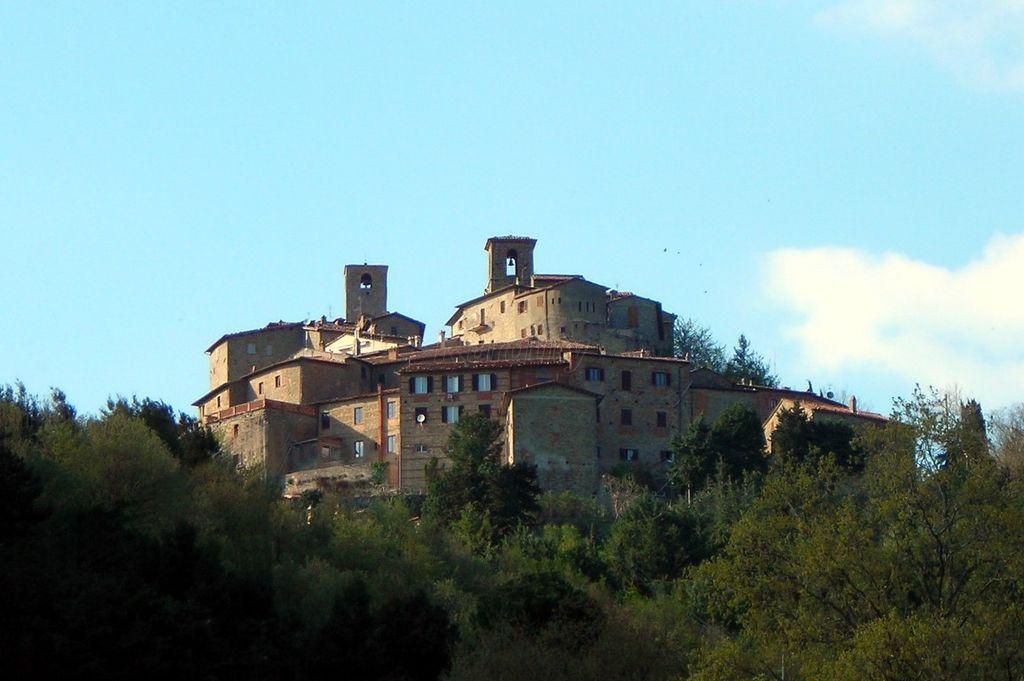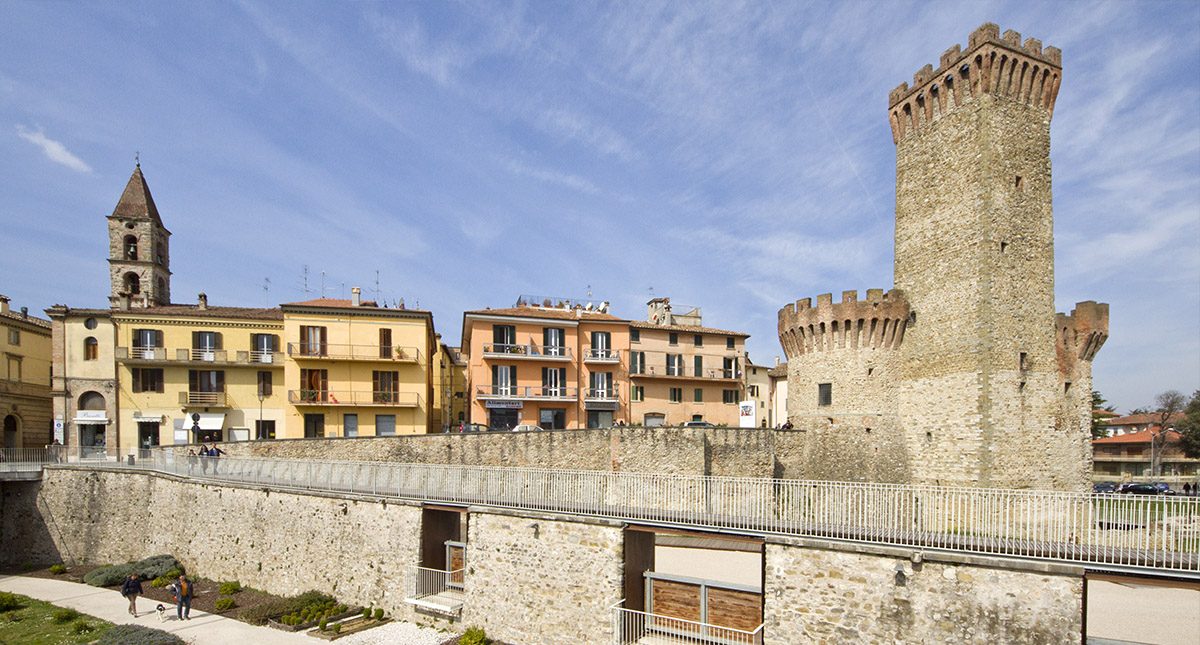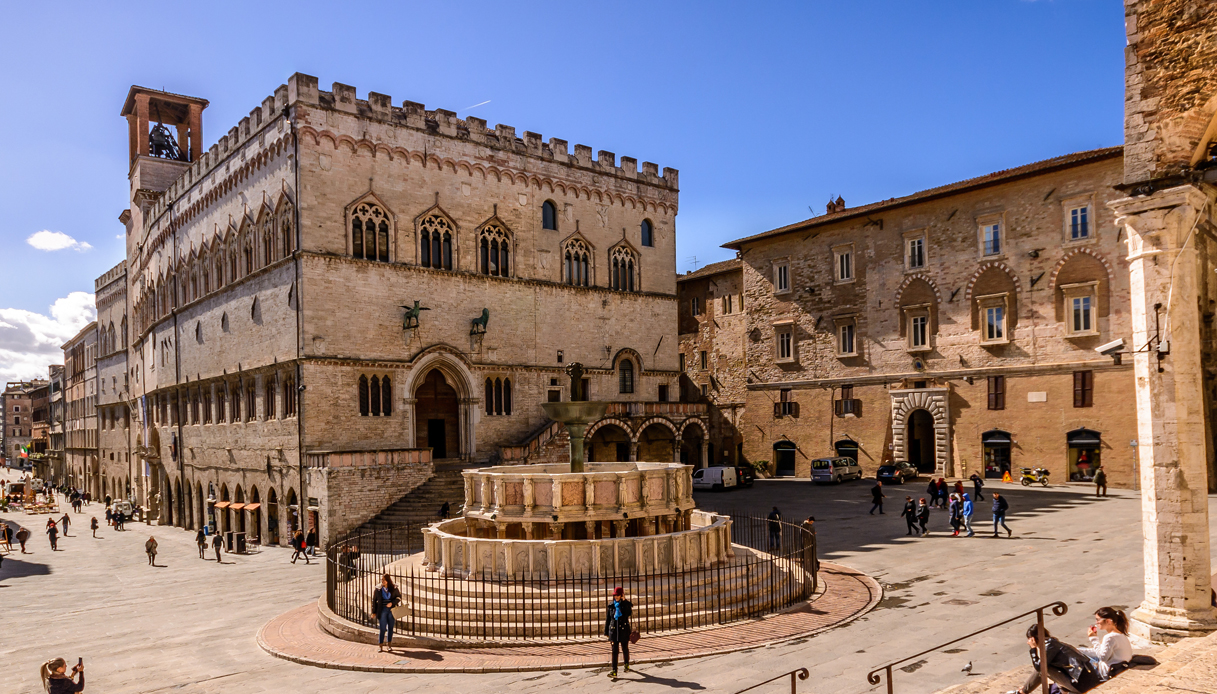It owes its name to the river of the same name, which flows from the springs of Monte Fumaiolo in Romagna into the artificial basin of Montedoglio, and then crosses Umbria and Lazio until it flows into the Tyrrhenian Sea. The valley, even if it constitutes a whole from the geographical point of view, already in the 15th century it was divided into two different political areas, one subject to the sovereignty of the Grand Duchy of Tuscany (today asserted in the province of Arezzo), the other under the dominion of the Papal State (in today’s province of Perugia). Its peculiarity as a border area, wedged between Tuscany, Umbria, Marche and Romagna, has made it an extremely varied territory from an artistic, folklore and gastronomic point of view. The itinerary that we propose leads to the discovery of the most picturesque villages of the Valtiberina, all located near the Somaia farm holidays.
(4 min from the farmhouse)
Don’t miss the Bufalini Castle: located in the centre of San Giustino, fortress of 1492, later transformed into a grand villa by Vasari, it is surrounded by an Italian style garden with a labyrinth. Just 2 km from San Giustino is the former Republic of Cospaia, a very small village in the middle of a strip of land which, due to a mistake in the division of borders between the Papal State and the Grand Duchy of Tuscany, remained a “no man’s land”, so much so that it became an independent state. Near San Giustino were also found the remains of an ancient Roman villa, which belonged to Pliny the Younger, exhibited at the Museo del . Near the hamlet of Celalba, you can admire the Villa Magherini-Graziani (1616); recently restored, it houses the Tobacco Museum (in fact, it is in the territory of the municipality of San Giustino that, in 1575, the cultivation of tobacco was started for the first time in Italy).
http://www.tguido.com/alta-valle-del-tevere/san-giustino/
Weekly local market:
– San Giustino: Friday
– Flints : Tuesday
– Blade: Thursday
– Monterchi : Sunday
The republic of Cospaia was a small independent territory from February 1441 to June 1826.
Currently it is a fraction of the Municipality of San Giustino.
The small became independent when, in February 1441, Pope Eugenio IV ceded the territory of Sansepolcro to the Republic of Florence. By mistake in the designation of the border, a small strip of land was excluded in the treaty that delimited the borders, and the inhabitants of Cospaia declared not to accept any authority.
For years the small community provided for its subsistence by cultivating tobacco, called by the “erba tornabuona”. For irrigation needs an embankment was raised as a dam to create a small lake. It was precisely in Cospaia that the clandestine cultivation and trade of tobacco brought a certain prosperity, but also a small invasion of smugglers, considering that smoking and sniffing tobacco were proclaimed illegal in the Papal States.
http://www.repubblicadicospaia.it/
http://www.umbriatouring.it/lincredibile-storia-di-cospaia/
(at 7min)
The main centre of the Tuscan Valtiberina, it boasts a valuable historical centre, closed by a wall bounded by gunboats and an imposing Medici Fortress (1350). The main square (Piazza Torre di Berta) is overlooked by Palazzo Pichi (16th century) and Palazzo Giovagnoli (13th century); a short distance away is the Duomo, a Romanesque-Gothic Cathedral with a large rose window. To the left of the Cathedral there are the Palazzo delle Laudi (1595), the Palazzo Pretorio (14th century, ancient seat of the Florentine government) and the Municipal Picture Gallery. The latter houses various works by Piero della Francesca, including the famous Resurrection. In the historical centre of Sansepolcro takes place every second Sunday of September the Palio della Balestra, an ancient and suggestive folklore event in costume. The town is the seat of important textile and food factories (the Buitoni brand, known all over the world, was born in Sansepolcro).
(at 15min)
In a dominant hilly position stands the majestic fortified village of Anghiari, whose fame derives from the fact that it was the scene of the Battle of Anghiari, fought in 1440 between the Florentines and Milanese, and immortalised in the famous fresco by Leonardo da Vinci in the Palazzo Vecchio in Florence (painted later covered by Vasari). The town has been included in the list of the “most beautiful villages in Italy” and awarded the Orange Flag of the Touring Club for its picturesque alleys, surrounded by stone houses, which maintain a timeless charm.
15 km from Anghiari, immersed in the Monti Rognosi Park, is Caprese Michelangelo (650m above sea level), a small village known for being the birthplace of Michelangelo Buonarroti. To visit the Castle and the Casa del Podestà, fourteenth century buildings that today house the Museum of Michelangiolesco. The village is the starting point for excursions to the top of the Alpe di Catenaia (1415m), from where you can enjoy a magnificent panorama that sweeps from the Marches to Abetone (the asphalted road reaches up to 1220m, in Faggeto.
(at 18 minutes)
Not far from Anghiari, it is worth visiting Citerna and Monterchi. The charm of Citerna lies in the ancient fortress and the medieval walkways, both in perfect condition, as well as in the elevated position from which you can enjoy a magnificent panoramic view of the whole Valtiberina. Monterchi is best known for the painting of the Madonna del Parto by Piero della Francesca, but also boasts a lovely castle dating back to the year 1000. Not to be missed, if you are visiting during the Christmas period, the suggestive Living Nativity, staged in the narrow streets of the historical centre of Monterchi.
(at 15min)
A flourishing town of Roman origins, the ancient Castrum Tifernum is today the real industrial engine of the Upper Tiber Valley, and stands out for its production of style furniture, cartography and metalwork. The city was deeply marked by the lordship of the Vitelli family, who governed it from the middle of the 15th century until the end of the 16th century, building a multitude of elegant palaces. The visit starts from Piazza Matteotti, the historical heart of the village, in whose eastern side there is the Palazzo Vitelli and in the western side the Palazzo del Podestà (that towards Piazza Matteotti has a baroque facade of 1686 and towards Corso Cavour a beautiful monumental side, all in stone, and with austere gothic shapes). Continuing on Corso Cavour you reach Piazza Gabriotti, where there is the Palazzo Comunale of 1334 (gothic building with an imposing atrium, with sturdy cross vaults). The left side of the Duomo (dating back to the year one thousand, but extensively remodeled in later times) follows: the left side is in Gothic style and the façade has baroque shapes. Below the cathedral there is the large Lower Church, which houses the stone sarcophagus containing the relics of Saints Amanzio and Florido (the latter is the patron saint of the city), and which houses the Cathedral Museum (with precious works of art that make up the cathedral’s treasure and the treasure of Canoscio. Opposite the side of the cathedral stands the Bishop’s Palace and the adjacent Civic Tower (m high, from which you can enjoy a magnificent view of the historic centre). In Via della Cannoniera there is Palazzo Vitelli alla Cannoniera (1521, whose rear part is adorned with valuable graffiti by Vasari), seat of the Municipal Picture Gallery, which houses an important collection of paintings (containing works by Ghirlandaio, Signorelli and Raffaello). The visit ends in Piazza Garibaldi, where you can admire the Palazzo Vitelli in Sant’Egidio, the most sumptuous palace of the seigniory.
On the hill above Città di Castello stands the Sanctuary of the Madonna del Belvedere (1669, interiors with grandiose baroque stuccoes). At 3,5 km from the town there are the Terme di Fontecchio, a thermal spa of the nineteenth century, known for its mud and its alkaline-sulphur waters.
Alberto Burri, one of the greatest Italian exponents of modern art was born and lived in Città di Castello. The master has donated over 250 works to the city, protected by the Burri Foundation, and exhibited at Palazzo Albizzini and the former tobacco drying rooms.
(at 30min)
Situated at an altitude of almost 700m, the village enjoys a superb view over the valley below; today almost uninhabited, it has kept all its medieval charm intact. Starting from the XI century it was the stronghold of the feud of the Marquis Bourbon del Monte who, having come to Italy following the Franks, conquered a large part of the Upper Tiber Valley. The 16th century castle and the church of Santa Maria with the crypt-sepolcro of the Bourbon del Monte family are worth a visit. Within the walls there is also a beautiful parish church of the Mille, where a valuable stone baptismal font is preserved.
(at 30min)
Situated at the southern end of the Valtiberina, Umbertide offers visitors attractions such as the church of Santa Maria della Reggia (a majestic 16th century building with an octagonal plan, surmounted by a dome), the church of Santa Croce (built in 1651, it houses the Deposition of the Cross, a remarkable panel by Signorelli), the Castle of Civitella Ranieri (built in the 15th century, it is considered the most beautiful and best preserved in the area; it is bordered by two cylindrical towers and two square towers) and the Abbey of Monte Corona (founded by San Romualdo in 1008, the order of the Camaldolesi Coronesi originated here; the crypt, the oldest part of the building, is very suggestive).
Montone is a village lying on a hill near Umbertide; of early medieval origin, it is known for having given birth in 1368 to Andrea Fortebraccio, famous mercenary captain who was lord of Perugia. The gothic church of San Francesco (with a beautiful carved wooden door and frescoes of the Umbrian school of the ‘300-‘400) and the Pieve di San Gregorio (XI century, in Romanesque-Byzantine style, contains a Madonna by Perugino and a silver reliquary in which the Holy Thorn of Montone is kept.
(45min from the farmhouse)
Perugia, a city of Etruscan Roman origin and capital of the Umbria region, is home to one of the oldest universities in Europe (founded in 1308). The city centre is made up of the splendid Piazza IV Novembre, where the most illustrious monuments are located: in the middle is the Fontana Maggiore (one of the most beautiful fountains of the thirteenth century, rich in bas-reliefs), to the north the side of the Cathedral of San Lorenzo with the Loggia di Fortebraccio and the former Seminary, to the west the Palazzo Arcivescovile, to the south the Palazzo Comunale whose side extends into Corso Vannucci, to the east a series of ancient buildings including the Collegio dei Notari. The Palazzo Comunale is a mighty 13th century building; to visit the magnificent Sala dei Notari on the first floor, on the third floor you will find the Galleria Nazionale dell’Umbria (the most important existing collection of Umbrian paintings, there are many works by Pinturicchio, Perugino and Signorelli) and on the ground floor the Sala del Collegio della Mercanzia (with a rich 15th century decoration). In Corso Vannucci is the entrance to the Collegio del Cambio, the ancient seat of the moneychangers of 1452 (the Sala dell udienza del Cambio, at times ogival, decorated with frescoes by Perugino). In Piazza Matteotti there is the Palazzo dell’Università Vecchia (seat of the University of Perugia from 1453 to 1811) and, in continuity with this, the elegant Palazzo del Capitano del Popolo. In Piazza Braccio Fortebraccio stands the Palazzo Gallenga Stuart (a sumptuous baroque building, today the seat of the Italian University for Foreigners), but above all the Etruscan Arch (a mighty monumental construction of the walls of ancient Perusia). At the end of Via del Tempio stands the suggestive church of Sant’Angelo, a singular early Christian building (originally from the 6th century, with a Gothic portal from the 14th century). Continue the visit taking you to the southern quarters of the city, which can be reached from the centre by the Via Marzia, which descends along the mighty spurs of the Rocca Paolina and where you will find the Porta Marzia (2nd century B.C.), from which you can access the underground Via Bagliona (which takes place within the perimeter of the Rocca Paolina with a very suggestive route in a medieval and 16th century environment). In Piazza Giordano Bruno stands the basilica of San Domenico (with a mighty bell tower, the interior is in the shape of a Latin cross with a nave and two aisles 122 m long), on the left of which there is access to the National Archaeological Museum of Umbria (includes an Etruscan-Roman section and a prehistoric section). Continuing along Corso Cavour you reach Porta San Pietro, which actually consists of two doors, the 14th century internal door and the Renaissance external door. Not far away stands the complex of the convent and the basilica of St. Peter’s (considered the most beautiful in Perugia, it has a hexagonal bell tower; the interior, with three naves divided by 18 Ionic columns of grey marble and oriental granite, is adorned with numerous valuable works of art).
Just 7 km from the historical centre is the Ipogeo dei Volumni, one of the best examples of a noble Etruscan tomb (2nd century B.C.). The tomb, dug into the ground and 4 m high for 100 square meters of surface, contains well-preserved Etruscan sculptures, including seven cinerary urns.

